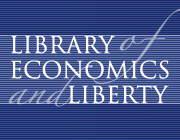
Lawrence Robert Klein |

In 1946 the conventional wisdom was that the end of World War II would sink the economy into a depression for a few years. Klein used his model to counter the conventional wisdom. The demand for consumer goods that had been left unsatisfied during the war, he argued, plus the purchasing power of returning soldiers, would prevent a depression. Klein was right. Later he predicted correctly that the end of the Korean War would bring only a mild recession.
Klein moved to the University of Michigan, where he proceeded to build bigger and more complicated models of the U.S. economy. The Klein-Goldberger model, which he built with then graduate student Arthur Goldberger, dates from that time. But in 1954, after being denied tenure for having been a member of the Communist party from 1946 to 1947, Klein went to Oxford University. There he built a model of the British economy.
In 1958 Klein joined the Department of Economics at the University of Pennsylvania. He has been a professor of economics and finance at the university's Wharton School since 1968. There he built the famous Wharton model of the U.S. economy, which contains over a thousand simultaneous equations that are solved by computers.
In 1976 Klein was coordinator of Jimmy Carter's economic task force but turned down an invitation to join Carter's new administration. In 1977 he was president of the American Economic Association.
(With Gary Fromm.) The Brookings Model. 1975.
Economic Fluctuations in the United States, 1921-1941. 1950.
The Economics of Supply and Demand. 1983.
(With Arthur S. Goldberger.) Econometric Model of the United States, 1929-52. 1955.
The Keynesian Revolution, 2d ed. 1966.
